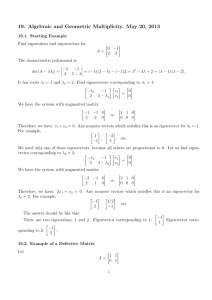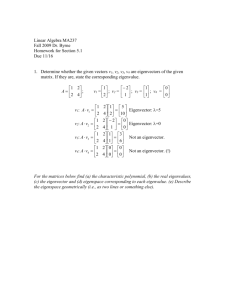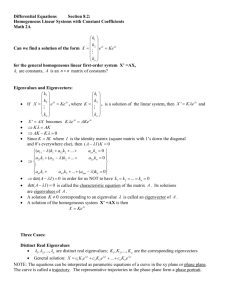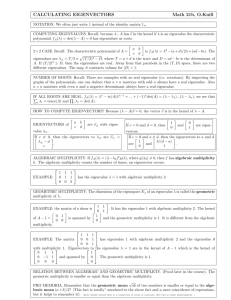Eigenvalues & Eigenvectors
advertisement
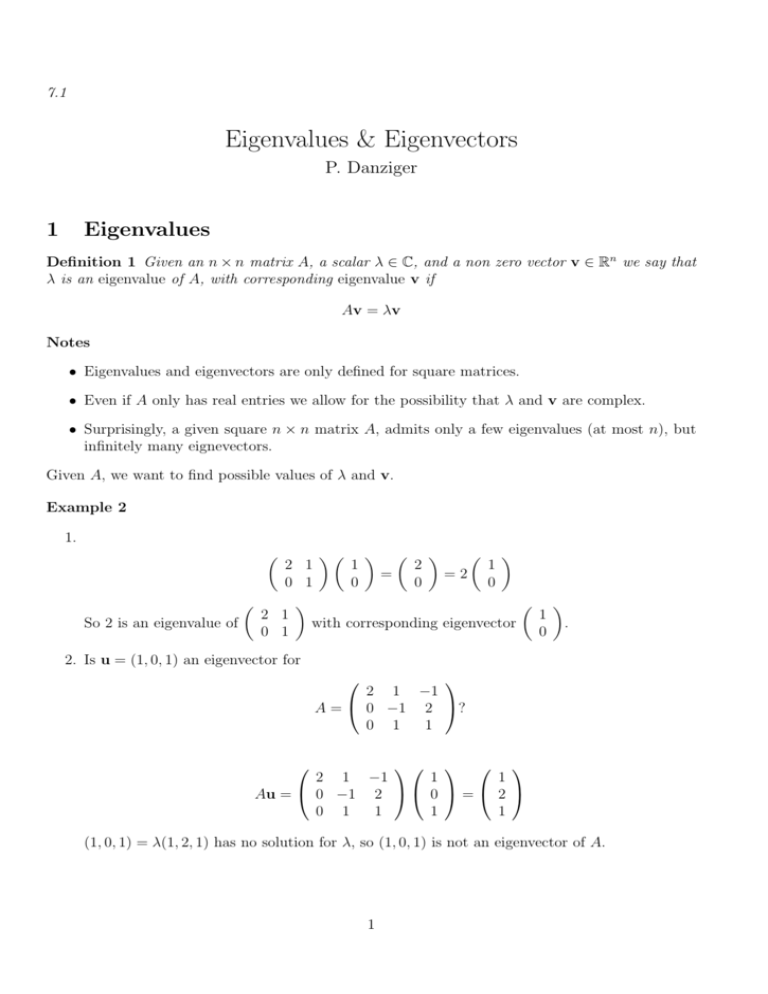
7.1
Eigenvalues & Eigenvectors
P. Danziger
1
Eigenvalues
Definition 1 Given an n × n matrix A, a scalar λ ∈ C, and a non zero vector v ∈ Rn we say that
λ is an eigenvalue of A, with corresponding eigenvalue v if
Av = λv
Notes
• Eigenvalues and eigenvectors are only defined for square matrices.
• Even if A only has real entries we allow for the possibility that λ and v are complex.
• Surprisingly, a given square n × n matrix A, admits only a few eigenvalues (at most n), but
infinitely many eignevectors.
Given A, we want to find possible values of λ and v.
Example 2
1.
2 1
1
2
1
=
=2
0 1
0
0
0
2 1
1
So 2 is an eigenvalue of
with corresponding eigenvector
.
0 1
0
2. Is u = (1, 0, 1) an eigenvector for
2 1 −1
A = 0 −1 2 ?
0 1
1
2 1 −1
1
1
0 −1 2
0
2
Au =
=
0 1
1
1
1
(1, 0, 1) = λ(1, 2, 1) has no solution for λ, so (1, 0, 1) is not an eigenvector of A.
1
7.1
2
Eigenvalues & Eigenvectors
P. Danziger
Eigenspaces
Theorem 3 If v is an eigenvector, corresponding to the eigenvalue λ0 then cu is also an eigenvector
corresponding to the eigenvalue λ0 .
If v1 and v2 are an eigenvectors, both corresponding to the eigenvalue λ0 , then v1 + v2 is also an
eigenvector corresponding to the eigenvalue λ0 .
Proof:
A(cv) = cAv = cλ0 v = λ0 (cv)
A (v1 + v2 ) = Av1 + Av2 = λ0 v1 + λ0 v2 = λ0 (v1 + v2 )
Corollary 4 The set of vectors corresponding to an eigenvalue λ0 of an n × n matrix is a subspace
of Rn .
Thus when we are asked to find the eigenvectors corresponding to a given eigenvalue we are being
asked to find a subspace of Rn . Generally, we describe such a space by giving a basis for it.
Definition 5 Given an n × n square matrix A, with an eigenvalue λ0 , the set of eigenvectors
corresponding to λ0 is called the Eigenspace corresponding to λ.
Eλ0 = {v ∈ Rn | Av = λ0 v}
The dimension of the eigenspace corresponding to λ, dim(Eλ0 ), is called the Geometric Multiplicity
of the Eigenvalue λ0
3
Characteristic Polynomials
Given square matrix A we wish to find possible eigenvalues of A.
Av
⇒
0
⇒
0
⇒
0
=
=
=
=
λv
λv − Av
λIv − Av
(λI − A)v
This homogeneous system will have non trivial solutions if and only if det(λI − A) = 0.
Example 6
Find all eigenvalues of
det(λI − A) =
=
=
=
=
1 1
A=
1 1
1 0
1 1
det λ
−
0 1 1 1
λ − 1 −1 −1 λ − 1 (λ − 1)2 − 1
λ2 − 2λ
λ(λ − 2)
So det(λI − A) = 0 if and only if λ = 0 or 2.
2
7.1
Eigenvalues & Eigenvectors
P. Danziger
Definition 7 Given an n × n square matrix A, det(λI − A) is a polynomial in λ of degree n. This
polynomial is called the characteristic polynomial of A, denoted pA (λ).
The equation pA (λ) = 0 is called the characteristic equation of A.
Example 8
Find the characteristic polynomial and the characteristic equation of the matrix
1 2 1
A = 0 2 −1
0 0 1
pA (λ) = det(λI − A)
λ − 1 −2
−1
λ−2
1
= 0
0
0
λ−1
= (λ − 1)(λ − 2)(λ − 1)
= (λ − 1)2 (λ − 2)
If A is an n × n matrix, pA (λ) will be a degree n polynomial. By the Fundamental Theorem of
Algebra, a degree n polynomial has n roots over the complex numbers. Note that some of these
roots may be equal.
Given an n × n square matrix A, with distinct eigenvalues λ1 , λ2 , . . . , λk , then
pA (λ) = (λ − λ1 )r1 (λ − λ2 )r2 . . . (λ − λk )rk
for some positive integers r1 , r2 , . . . , rk .
Definition 9 For a given i the positive integer ri is called the algebraic multiplicity of the eigenvalue
λi .
Theorem 10 For a given square matrix the geometric multiplicity of any eigenvalue is always less
than or equal to the algebraic multiplicity.
Example 11
Find the distinct eigenvalues of A above and give the algebaraic multiplicity in each case.
pA (λ) = (λ − 1)2 (λ − 2)
So the distinct eigenvalues of A are λ = 1 and λ = 2.
The algebraic multiplicity of λ = 1 is 2.
The algebraic multiplicity of λ = 2 is 1.
3
7.1
4
Eigenvalues & Eigenvectors
P. Danziger
Finding Egenvalues & Eigenspaces
Note if we are asked to find eigenvectors of a matrix A, we are actually being asked to find
eigenspaces.
Given an n × n matrix A we may find the Eigenvalues and Eigenspaces of A as follows:
1. Find the characteristic polynomial
pA (λ) = |λI − A|.
2. Find the roots of pA (λ) = 0, λ1 , . . . , . . . λk ,n roots with possible repetition.
pA (λ) = (λ − λ1 )r1 (λ − λ2 )r2 . . . (λ − λk )rk
3. For each distinct eigenvalue λi in turn solve the homogeneous system
(λi I − A)x = 0
The solution set is Eλi .
Example 12
1. Find all eigenvalues and eigenvectors of
A=
1 1
1 1
λ − 1 −1
pA (λ) = |λI − A| = −1 λ − 1
Solutions are λ = 0 or 2.
λ = 0 Solving −Ax = 0.
−1 −1 0
R2 → R2 − R1
−1 −1 0
= λ(λ − 2)
−1 −1 0
0
0 0
Let t ∈ R, x2 = t, x1 = −t, so
E0 = {t(−1, 1) | t ∈ R}.
λ = 2 Solving (2I − A)x = 0.
1 −1 0
R2 → R2 + R1
−1 1 0
1 −1 0
0 0 0
Let t ∈ R, x2 = t, x1 = t, so
E2 = {t(1, 1) | t ∈ R}.
In both cases Algebraic Multiplicity = Geometric Multiplicity = 1
4
7.1
Eigenvalues & Eigenvectors
P. Danziger
2. Find all eigenvalues and eigenvectors of
1 2 1
A = 0 2 −1
0 0 1
We proved earlier that
pA (λ) = (λ − 1)2 (λ − 2)
So eigenvalues are λ = 1 and λ = 2.
λ = 1 has algebraic multiplicity 2, while λ = 2 has algebraic multiplicity 1.
λ = 1 Solving (I − A)x = 0.
1 0 0
0 1 0
0 0 1
0 −2 −1
0 −1 1
=
0 0
0
0
1 2 1 0
0 − 0 2 −1 0
0
0 0 1 0
0
0 1 −1 0
0
0 0 1 0
→
0
0 0 0 0
Let t ∈ R, set x1 = t and x3 = 0, x2 = 0.
E1 = {t(1, 0, 0) | t ∈ R}
geometric mutiplicity = 1 6= algebraic multiplicity.
λ = 2 Solving (2I − A)x = 0.
=
2 0 0
0 2 0
0 0 2
1 −2 −1
0 0
1
0 0
1
1 −2 −1
0 0
1
0 0
0
0
0
0
0
0
0
0
0
0
1 2 1 0
− 0 2 −1 0
0 0 1 0
R3 → R3 − R2
Let t ∈ R, set x2 = t and x3 = 0, x1 = 2t.
E2 = {t(2, 1, 0) | t ∈ R}
Theorem 13 If A is a square triangular matrix, then the eigenvalues of A are the diagonal entries
of A
Theorem 14 A square matrix A is invertible if and only if λ = 0 is not an eigenvalue of A.
Theorem 15 Given a square matrix A, with an eigenvalue λ0 and correspoonding eigenvector v,
then for any positive integer k, λk0 is an eigenvalue of Ak and Ak v = λk0 v.
5
7.1
Eigenvalues & Eigenvectors
P. Danziger
Theorem 16 If λ1 , . . . , λk are distinct eigenvalues of a matrix, and v1 , . . . , vk are corresponding
eigenvectors respectively, then the are linearly independent. i.e. Eigenvectors corresponding to distinct eigenvalues are linearly independent.
Corollary 17 If A is an n × n matrix, A has n linearly independent eigenvectors if and only if the
algebraic multiplicity = geometric multiplicity for each distinct eigenvalue.
6
